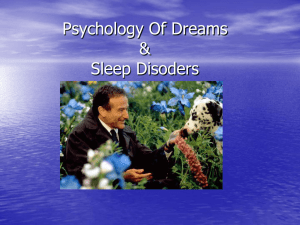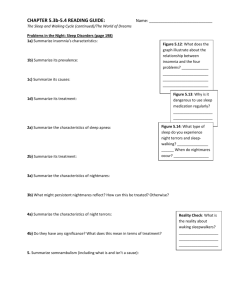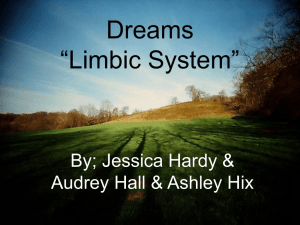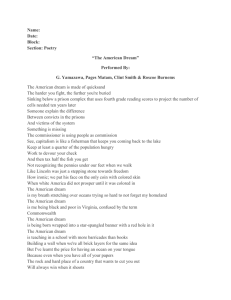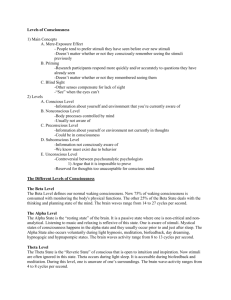Kristin Staub
advertisement
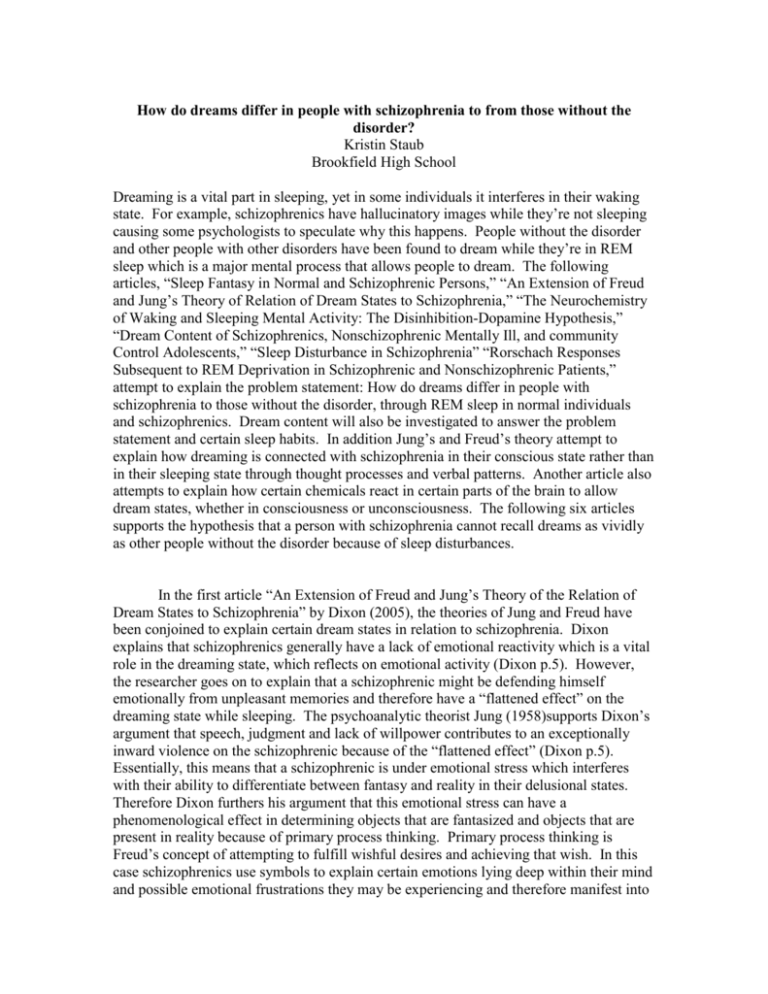
How do dreams differ in people with schizophrenia to from those without the disorder? Kristin Staub Brookfield High School Dreaming is a vital part in sleeping, yet in some individuals it interferes in their waking state. For example, schizophrenics have hallucinatory images while they’re not sleeping causing some psychologists to speculate why this happens. People without the disorder and other people with other disorders have been found to dream while they’re in REM sleep which is a major mental process that allows people to dream. The following articles, “Sleep Fantasy in Normal and Schizophrenic Persons,” “An Extension of Freud and Jung’s Theory of Relation of Dream States to Schizophrenia,” “The Neurochemistry of Waking and Sleeping Mental Activity: The Disinhibition-Dopamine Hypothesis,” “Dream Content of Schizophrenics, Nonschizophrenic Mentally Ill, and community Control Adolescents,” “Sleep Disturbance in Schizophrenia” “Rorschach Responses Subsequent to REM Deprivation in Schizophrenic and Nonschizophrenic Patients,” attempt to explain the problem statement: How do dreams differ in people with schizophrenia to those without the disorder, through REM sleep in normal individuals and schizophrenics. Dream content will also be investigated to answer the problem statement and certain sleep habits. In addition Jung’s and Freud’s theory attempt to explain how dreaming is connected with schizophrenia in their conscious state rather than in their sleeping state through thought processes and verbal patterns. Another article also attempts to explain how certain chemicals react in certain parts of the brain to allow dream states, whether in consciousness or unconsciousness. The following six articles supports the hypothesis that a person with schizophrenia cannot recall dreams as vividly as other people without the disorder because of sleep disturbances. In the first article “An Extension of Freud and Jung’s Theory of the Relation of Dream States to Schizophrenia” by Dixon (2005), the theories of Jung and Freud have been conjoined to explain certain dream states in relation to schizophrenia. Dixon explains that schizophrenics generally have a lack of emotional reactivity which is a vital role in the dreaming state, which reflects on emotional activity (Dixon p.5). However, the researcher goes on to explain that a schizophrenic might be defending himself emotionally from unpleasant memories and therefore have a “flattened effect” on the dreaming state while sleeping. The psychoanalytic theorist Jung (1958)supports Dixon’s argument that speech, judgment and lack of willpower contributes to an exceptionally inward violence on the schizophrenic because of the “flattened effect” (Dixon p.5). Essentially, this means that a schizophrenic is under emotional stress which interferes with their ability to differentiate between fantasy and reality in their delusional states. Therefore Dixon furthers his argument that this emotional stress can have a phenomenological effect in determining objects that are fantasized and objects that are present in reality because of primary process thinking. Primary process thinking is Freud’s concept of attempting to fulfill wishful desires and achieving that wish. In this case schizophrenics use symbols to explain certain emotions lying deep within their mind and possible emotional frustrations they may be experiencing and therefore manifest into dream states in the waking consciousness (Dixon p.6). Cameron (1938) explains that there is imprecision and incongruency between acts and words and therefore schizophrenics have a hard time trying to handle their emotional problems which manifest into dream-waking states (Dixon p. 7). In this sense, they also have certain postulation systems which are distorted, because postulation is supposed to assume that something is considered true and real. They are not able to differentiate if something is real or not (Dixon p.10). Jung (1958) explains that in normal people dreams reflect people or objects that are represented in their external environment whereas in schizophrenics there are random objects that appear absurd and fragmentary. That’s why they have certain delusions in their conscious waking state (11). In the next topic, “Sleep Disturbance in Schizophrenia,” Wulff, (2006) did a case study to explore the abnormal sleeping patterns of schizophrenics that potentially disrupts the daily routine of a person. In addition they have shorter dream recall than those without the disorder along with less personal involvement, anxiety as a result of sleep disturbances. A 27-year-old man would have urinary samples collected from him every 48 hours while he is at home. The urinary samples would reveal levels of abnormal melatonin production. Melatonin production would be able to predict how much sleep the individual actually gets. The researchers also used actigraphy which is a portable wrist-watch sized unit worn on the least dominant arm using accelerometer sensors to detect light waves either outside or inside the home. The patient then had to write in their diary of their daily sleeping routines and their other daily routines (Wulff p. 485). After all the urinary samples were collected, the results indicated that the subject showed a progressive delay in sleep. This means his biological clock was off, and in the last week it completely reversed. He did not sleep when it was dark as normal people would, and some days he would sleep all day. It is concluded that light can drive a person to have delayed sleep activity, especially in schizophrenia. However this lack of sleep could also pertain to the medication the patient was using therefore affecting his sleep cycle. Even though this is a medicated schizophrenic patient, a person who is not institutionalized could have even more severe cases of sleep delay (Wulff p. 493). In relation to the previous article, the next article, “The Neurochemistry of Waking and Sleeping Mental Activity: The Disinhibition-Dopamine Hypothesis,” Claude Gottesmann attempts to explain the neurochemistry of dream states in schizophrenia and the disinhibition-dopamine hypothesis. He explains that dreaming is disorderly and fragmented like the symptoms of schizophrenia in their waking delusional states. In support Schopenhauer and Maury state that dreams are a brief madness and are a kind of delusion (p. 345). Dreams mainly occur in the cerebral cortex structure of the brain especially in the dorsolateral prefrontal cortex where it is deactivated during dreaming.. This allows for reasoning and logic to be absent in the dream state. This decrease in logic and reasoning occurs during REM (rapid eye movement) sleep. REM sleep is the stage of sleep that occurs throughout marked periods of the night with rapid eye movement and brain activity. Normal people have dopamine levels that increase in the cortex while sleeping therefore, increasing brain activity accounts for visual images (Gottesmann p. 347). However, in schizophrenics Gottesmann notes that in schizophrenics the opposite is true in the dream state. There is a decrease in dopamine production during REM sleep allowing the dorsolateral prefrontal cortex (DLPFC) to deactivate during the dream state. Therefore, dream content is non-reactive in schizophrenics because the DLPFC is not able to produce images in this dream state or is fragmented. Furthermore, an increase in dopamine levels accounts for hallucinations and delusions in waking states (p. 349). Gottesmann mentions that dreams are made up of visual contents yet in schizophrenia there is an increase in auditory hallucinations which accounts for the dopamine being dysfunctional in most people with psychoses (p. 348). IN addition the decrease in dopamine production also contributes to the decrease in REM sleep appearance therefore dreams do not appear as vividly (p. 349). In response to the previous article of REM sleep, Vincent Zarcone (1965) did a case study, “Rorschach responses subsequent to REM deprivation in schizophrenic and nonschizophrenic patients,” using schizophrenic patients and nonschizophrenic patients to test REM deprivation. He hypothesized that schizophrenics have a lack of dream content and REM sleep which results in behavior disruptions. All subjects in this study were deprived of 75% REM sleep. Each night before they slept he used the Rorschach test (248) to gauge their responses. During the night he used the EEG, EOG, and EMG to record electric pulses in the brain. After they awoke in the morning he used the Rorschach test again to gauge responses. Each test would determine their adaptiveness or maladaptiveness and how well they respond to each of the cards used. The results did not show many differences, but when a second analysis was conducted it showed a significant difference in adaptive aggression. This means that schizophrenics had a harder time controlling their responses as a result of a lack of REM sleep. In another response to REM sleep and schizophrenics, “Sleep Fantasay in normal and schizophrenic persons” is a study that was done by Rosalind Dymond Cartwright (1971) comparing sleep fantasy between normal and schizophrenic people. In this study three groups were tested. He hypothesized that the three groups would differ significantly in fantasy levels, and a second hypothesis states that dream content would be less vivid in schizophrenics. Several scientists support this hypothesis. He uses an EEG monitor to prove that schizophrenics think conceptually during the day and hallucinations during REM sleep. For four consecutive nights the patients were admitted into the psychiatric hospital dream content tests were administered using the MMPI. Results were extracted from other studies that Cartwright used to support his study. Hence the results from all the studies showed that the three groups had significant differences in fantasy levels during REM awakenings. Groups 1 and 2 were shown to be significant from group 3. The results from the experiment prove that REM dreaming is related to the psychological disturbance of schizophrenics and dream content would be less vivid in schizophrenia. As the disturbance levels increase in schizophrenics, the more widely distributed the episodes of hallucinatory images are. In relation to the previous article another case study was done by Jack Hadjez (2003), “Dream Content of Schizophrenic, Nonschizophrenic Mentally Ill, and community Control Adolescents,” to measure dream content in nonschizophrenic mentally ill adolescents, schizophrenic adolescents, and community control adolescents. He hypothesized that schizophrenics have some incoherency and implausibility in their dreams, with less anxiety, personal involvement and emotional expression. IN addition they also have shorter dream recall, if hardly any (Hadjez p.332). To conduct this study Freud’s psychoanalytic theory of dreams was used and he claims that dreams are supposed to help resolve conflict and impulses in a more acceptable manner than in waking states, (Hadjez p. 331). The test used, Formal Dream Content Rating Scale (FDCRS) includes the measurement of anxiety, cognitive disturbance, implausibility, involvement, primitivity, emotional expression, and duration of dream report to evaluate the outcome of the study. All participants were administered the test and interviewed between 8 and 9 AM in the morning so the participants could more easily remember their dreams. All the interviews were taped and analyzed independently. Results showed that there were no considerable differences between the groups in dream content (Hadjez p. 335). However, there was significantly less involvement and emotional expression from the schizophrenic patients, but there were no significant correlations between the three groups. Hadjez found that adolescents with schizophrenia were not more disturbed than other patients with other disorders. However, the community control adolescents had more vivid dreams than schizophrenic or nonschizophrenic patients. In addition, schizophrenic dreams were more symbolic and there was an overall emotional and cognitive constriction as the primary manifestations of dreams in schizophrenia (Hadjez p. 338). All these sources confirm that schizophrenics do not have very vivid dreams and tend to have a very inactive DLPFC during REM sleep, which further explains why they have sleep disturbances as well. Freud and Jung’s psychoanalytic theories of dreams proved to be a supporter of the hypothesis that schizophrenics have trouble handling certain emotional issues that in turn causes them to have delusions and hallucinations in the conscious state. This is very important for diagnosing patients with schizophrenia because lack of emotional expression and vividness in dreams could be a sign. The four case studies presented all pointed to the fact that schizophrenics are unable to sleep properly and have less dream content than those without the disorder. Not only that, but their sleep cycle is disturbed as shown in the study with melatonin samples and use of actigraphy. By presenting Jung’s and Freud’s theory first provided a basis for the problem confronting schizophrenia and dreams, which then leads to their sleep disturbance cycle which then leads to other case studies of how the content in their dreams are primitive. One flaw in most of the articles was that they mostly dealt with patients having other disorders rather than normal people which was in my initial question, however there were some articles that explained the processes in the brain of how dreams occur in normal people. I thought it was important to establish how dreams work in normal people so then readers could have a better understanding of what the differences are between normal and schizophrenic people. The methods used to calculate dreams were very useful especially the actigraphy and the melatonin test which detected sleep disturbances within the patient. Another good indicator was the Rorschach test which tested the responsivity of the patients after a lack of REM sleep. Then the diaries were important because they explain certain sleeping patterns and dream recalls that most of these patients had. Outside of the psychological stance, these articles and cases could provide a deeper understanding of dreams between people without schizophrenia and those with schizophrenia. This is especially useful for doctors who are trying to find medicines to reduce the delusions and REM deprivation. In addition, it is important to have dreams to deal with certain emotional issues a person might have in their waking life. If a person does not have these dreams then their emotional problems in real life will become stressful and the person will be unable to resolve these emotional issues. Hence, it is important to study schizophrenia and dreams because the disease can interfere with everyday life. Therefore it makes it harder for the person to function socially with other people and have an appropriate sleep cycle. Much is still not known about dreams in schizophrenia because the concept is very complex and can also be inaccurate. Dream recall can especially be inaccurate because the person can alter the true results of the content of their dreams. Therefore, a better method for dream recall still needs to be found in order to have precise results. Right now, diaries, EEGs, melatonin tests, actigraphies, and the Rorschach test are the most accurate instruments used for testing dream vividness and content. For the research design a study should be conducted with several schizophrenic patients who do not take medications and several people without disorders to provide more accurate results. First, the study should measure sleep disturbance using actigraphies and urinary samples to measure melatonin. Every subject will be hooked up to an EEG monitor to measure brain wave activity while they are sleeping. This should be done in a month. Everyday each subject will have a diary and after they wake up they should write down in their diary the dreams they had. Then the Rorschach test should be administered to the subjects to gauge their responses to the images they see. By using this research design, perhaps results will be more accurate and more able to differentiate dreams or symptoms between schizophrenics and people without disorders. Also this study will help explain how exactly brains of schizophrenics function when there is a lack of dream content. Works Cited Cartwright, Rosalind D. “Sleep Fantasy in normal and schizophrenic persons.” Journal of Abnormal Psychology 80 (Dec. 1972): 275-279. Rpt. in The Journal of Abnormal Psychology. PsycINFO. EBSCO. Brookfield High School Lib., Brookfield, CT. 23 Nov. 2008 <http://search.ebscohost.com/ login.aspx?direct=true&db=psyh&AN=1973-09314-001&site=ehost-live>. Dixon, Paul W. “An Extension of Freud and Jung’s theory of the Relation of Dream States to Schizophrenia.” Current Psychology 24 (Nov. 2005): 4-23. Rpt. in Current Psychology. PsycINFO. EBSCO. Brookfield High School Lib., Brookfield, CT. 23 Nov. 2008 <http://search.ebscohost.com/ login.aspx?direct=true&db=psyh&AN=2005-13775-001&site=ehost-live>. Gottesmann, Claude. “the neurochemistry of waking and sleeping mental activity: the disinhibition-dopamine hypothesis.” Psychiatry and Clinical Neurosciences 56 (Aug. 2002): 345-354. Rpt. in Psychiatry and Clinical Neurosciences. PsycINFO. EBSCO. Brookfield High School Lib., Brookfield, CT. 23 Nov. 2008 <http://search.ebscohost.com/login.aspx?direct=true&db=psyh&AN=200215703-001&site=ehost-live>. Hadjez, Jack. “Dream Content of Schizophrenic, Nonschizophrenic Mentally Ill, and Community Control Adolescents.” Adolescence 38 (Oct. 2003): 331-342. Rpt. in Adolescence. PsycINFO. EBSCO. Brookfield High School Lib., Brookfield, CT. 23 Nov. 2008 <http://search.ebscohost.com/>. Monti, Jaime M. “Sleep Disturbance in Schizophrenia.” International Review of Psychiatry 17 (Aug. 2005): 247-253. Rpt. in Psychology and Behavioral Sciences Collection. PsycINFO. EBSCO. Brookfield High School Lib., Brookfield, CT. 23 Nov. 2008 <http://search.ebscohost.com/ login.aspx?direct=true&db=pbh&AN=17523102&site=ehost-live>. Zarcone, Vincent. “Rorschach responses subsequent to REM deprivation in schizophrenic and nonschizophrenic patients.” Journal of Clinical Psychology 30 (July 1974): 248-250. Rpt. in Journal of Clinical Psychology. PsycINFO. EBSCO. Brookfield High School Lib., Brookfield, CT. 23 Nov. 2008 <http://search.ebscohost.com/login.aspx?direct=true&db=psyh&AN=197624215-001&site=ehost-live>.
